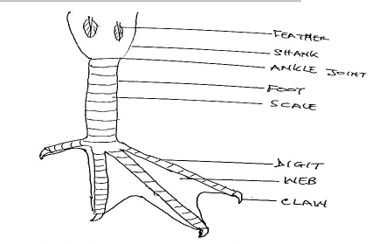LIST OF SPECIMENS
Specimen A – Weevil-damaged bean seed
Specimen B – Viable bean seed
Specimen C – Dried maize grain soaked in water overnight
Specimen D – Soldier termite (dead)
Specimen E – Honeybee (dead)
Specimen F – Muddy water (in a test tube)
Specimen G – Lower jaw of a herbivore with teeth intact
Specimen H – Head of domestic fowl (complete)
Specimen J – Quill feather
Specimen K – Leg of domestic fowl (complete)
Specimen L – Head of duck (complete)
Specimen M – Head of domestic fowl (complete)
QUESTION 3:
Study specimens H, K and M and answer questions 3(a) to 3(f).
(a) State two observable structural differences between:
(i) specimens H and L; [2 marks]
(ii) specimens K and M. [2 marks]
(b) (i) State two ways each by which each of specimens H and M adapt the organisms to
their modes of life. [8 marks]
(ii) Name types of food that the organism that possesses specimen H feeds on.
[2 marks]
(c) Make a drawing, 8 cm to 10 cm long of specimen M and label fully.
[9 marks]
(d) Name one feeding habit of the organisms that possesses specimen K.
[1mark]
(e) Name one feeding habit of each of the organisms that possesses
specimens H and L: [2 marks]
(f) State two observable similarities between specimens:
(i) H and L; [2marks]
(ii) K and M. [2marks]
Candidates’ performance in this question was average as a few candidates were able to correctly state observable differences between specimens H and L and specimens K and M.
A few candidates correctly stated how specimens H and M adapt the organisms to their modes of life.
Quite a large number of candidates could not correctly draw specimen M, hence, they lost marks.
The expected answers are:
3. (a) Observable structural differences between
(i) specimens H and L
H/head of domestic fowl |
L/head of duck |
|
comb absent; |
|
flat/broad beak; |
|
long beak; |
|
wattle absent; |
|
serrated beak. |
(ii) specimens K and M
K/leg of domestic fowl |
M/leg of duck |
|
webbed toes/digits; |
|
less curved/shorter/less pointed/curved claw; |
|
reduced backward digit; |
|
Hind digit short. |
(b) (i) Ways by which specimens H and M adapt the organisms to their modes of life
H
- Eye at the side of head; to focus on food on the ground/wide vision;
- Short/stout beak; for picking grains/seeds from the soil/preening/courtship
M
- Webbed digits; for paddling/swimming;
- Long digits; to balance while walking on land/muddy water to get food;
- Claws; for defence/scratching land to search for food;
- Scales; to minimize desiccation/protection.
(ii) Type of food of the organism that possesses specimen H
- Grains/seeds;
- Worms;
- Vegetables;
- Insects/any correctly named insect.
(c) Drawing/Diagram of specimen M/leg of duck

Title (TL) Drawing/Diagram of specimen M/leg of duck
Quality (Q)
Clarity of lines (CL)
Size (SZ) (8 cm to 10 cm)
Neatness of labels (NL) All guidelines ruled -½ mark;
All labels horizontal -½ mark
Magnification (MG) (×/×0.5 to ×1)
Details (D)
Webbed digit (WD) (at least two webs)
Scale on foot (SF)
Opposable digits (OD)
Labels (L)
Web, claw, digit, scale.
(d) Habitat of the organism that possesses specimen K
Hen coop/terrestrial/land/on a tree/poultry farm/homes/cage/farmyard.
(e) Feeding habit of specimens H and L
H: Omnivore/omnivorous animal.
L: Filter feeding.
(f) Observable Similarities between specimens
(i) H and L
Both have:
- Beaks; - Ear openings;
- Eyes; - Feathers;
- Nostrils; - Neck.
(i) K and M
Both have:
- Digits/four digits/three digits pointing forward and one digit pointing backward;
- Scales;
- Claws.
